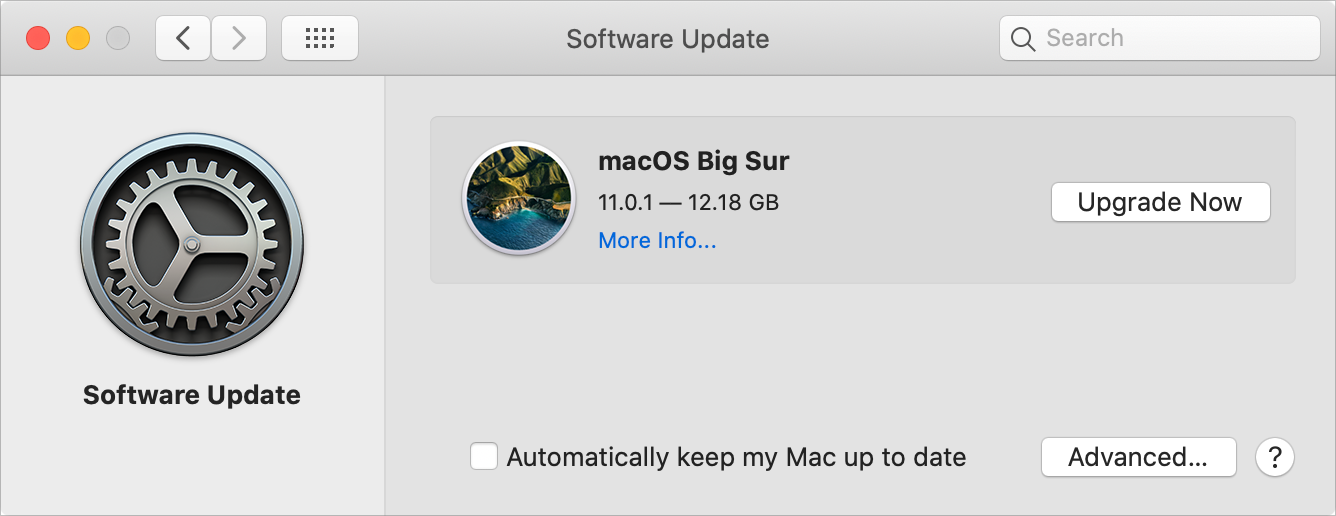Apple released macOS Big Sur on November 12, 2020. macOS Big Sur continues the list of Central California landmarks as well as marks the new operating system for Mac. Those who tried it say that it’s more stable. It also sports a refreshed version of Safari that is 50% faster than Chrome. Here’s how to perform a clean install of macOS Big Sur with pictures and helpful tips along the way.
What is a clean install? (Big Sur or any other macOS)
A clean install means that you install the macOS onto the erased drive.
Why is clean install more preferable?
A clean install is the opposite of macOS upgrade. You format your hard drive, and therefore, it keeps no leftovers from the previous macOS.
- macOS performs faster
- You get rid of apps you don’t use
- Persistent issues may go away
At this point, we have successfully created the macOS Big Sur USB Installer. But, in order to install the Hackintosh, we still need to configure the EFI folder. I will cover this in the next post because otherwise, this post will be very long. Check the following article to install macOS Big Sur on AMD FX system. Apple’s 2020 OS is an absolute hit. Here’s how to perform a clean install of macOS Big Sur and reinstall macOS Big Sur from a bootable USB drive. Follow the instruction!
Basic steps to clean install macOS Big Sur
The first step is to clean and back up your Mac to some external source. Then, you’ll need to download macOS Big Sur package to your Applications. Next, you’ll need to create a bootable USB installer (involves another external drive). And lastly, we’ll use Disk Utility to erase your Mac and install macOS Big Sur using the bootable USB device.
1. Clean & Back up your Mac
Cleanup
Cleaning your Mac is generally a healthy practice but since we’re about to back your Mac up, it’s worthwhile to get rid of system junk first. After we’ve cleaned your Mac, you’ll end up with a refreshed system ready for a Time Machine backup.
Time Machine will make a snapshot of your system.But before that we’ll ensure there's no unwanted leftovers on your entire Mac. To clean your machine automatically, you can run CleanMyMac X. This tool is one of the best-known cleaning utilities for Mac, and it’s been notarized by Apple.
Download the free version of CleanMyMac X cleaner here.
Install the app and click on System Junk to perform the scan.
Back up your Mac
Now, you’re ready to back up your computer. There is a tool built just for that purpose, you guessed it, Time Machine. Time Machine needs a storage source onto which it will copy your system.
So, you’ll need an external drive. This is the first external drive that we will use to clean install macOS Big Sur. This is the reserve backup for the worst-case scenario.
- Go to System Preferences > Time Machine.
- Connect an external drive (that’s more spacious than your current system).
- Select this Disk as a backup source in Time Machine.
Well done. The preliminary steps are done with, and we’re ready to clean install macOS Big Sur.
2. Download macOS Big Sur installer
macOS Big Sur has been released on November 12, 2020.
Since the public release in the fall of 2020, macOS Big Sur can be downloaded from the Mac App Store. It also can be found in the Software Updates pane in System Preferences.
So you’ll find it in System Preferences > Software Updates.
- Click Upgrade Now
Wait for the installer to download onto your drive. You will see the macOS Big Sur intro screen.
Don’t click Continue but for now, close this window by choosing Quit Install.
We only want to make sure that the app called Install macOS Big Sur.App is now firmly sitting in your Applications.
This is the file we’ll use later to run the clean install of macOS Big Sur via Disk Utility.
Now, and only now have we come to clean installing macOS Big Sur. This is only a short stop on the road, so catch your breath, and let’s move along.
3. Create a bootable Big Sur installer
Now, it’s time to grab another USB flash drive and connect it to your Mac. This drive should have at least 16 GB of storage space.
Wipe the drive clean with Disk Utility
- Pick this drive and click Erase in the top menu.
- Double-check what you’re erasing.
- Make sure the USB drive is shown as “Untitled”
- Under Format, choose: Mac OS Extended (Journaled)
All data on that disk will be lost, so beware.
Go to Terminal (Phew, we’re almost there)
This step will actually create the source disk so we can install Big Sur from bootable USB.
Launch Terminal app from your Launchpad.
Paste in the following command:
sudo /Applications/Install macOS Big Sur.app/Contents/Resources/createinstallmedia --volume /Volumes/Untitled
Type in your admin password and press Return and Y to confirm the action.
This command creates a bootable USB installer based on macOS Big Sur.app, which we’ve previously placed in your Applications.
4. Erase your startup drive in Disk Utility
It’s time to wave goodbye to your current configuration. Remember, we’ve already cleaned it up from junk with CleanMyMac X and backed it up onto our first reserve USB drive.
Now, start your Mac in Recovery mode:
- Turn off your Mac and hold down Command + R.
- Choose Disk Utility from the menu.
- Choose your main startup drive and click Erase.
Voila! Your Mac is now formatted. What you can do now (actually, this the only thing you can do now) is to clean install macOS Big Sur 11 from the connected USB installer drive. If it’s not connected, connect the bootable USB installer now.
- Go back to the original Disk Utility screen
(If you can’t return to Disk Utility, restart your Mac and hold down the Option key) - Click Install macOS and choose to install it from the selected USB drive.
- Click on “Install macOS”
How do I regularly install macOS Big Sur?
The regular install is done via upgrading your current macOS. That is, you don’t erase your entire disk. When the new macOS Big Sur is officially released, you just open the App Store > Updates.
Or even better, go to your System Preferences > Software Updates
Install Mac Big Sur From Usb
How to reinstall macOS Big Sur?
If for some reason your Big Sur macOS doesn’t work as expected, you can reinstall it by sending your Mac into Recovery Mode.
- Restart your machine and hold down ⌘ + R
- Choose Reinstall macOS
That’s it.
As we’ve just seen, running a clean install of macOS Big Sur could be a crazy rabbit hole. We hope you survived. Now you’ll be rewarded with the best Apple’s operating system up to date. You’ll also have a clean Mac that works at blazing speed with a little extra help from our favorite Mac cleaner — CleanMyMac X. You can get started with a trial version — so download it here.
Best apps live in Setapp
A free public version of macOS Big Sur 11 has been available since November 12, 2020. It offers the best Safari we’ve ever seen, a huge design upgrade, and one very neat Control Center. Ready to dive in? Let’s see how you can do it.
There are two ways to install a new macOS: 1) run a regular upgrade via Apple’s main menu (replace your current macOS with Big Sur on your startup drive); 2) start from scratch and clean install macOS. Option number 2 is a bit more cumbersome and takes more time — but there are many benefits to it. In this article, we explain how to clean install macOS Big Sur without any trouble and why it’s good for your Mac.
Why you should clean install macOS 11
As soon as the new macOS appears, we can’t wait to try it. With Apple promising lots of awesome enhancements, it’s hard to resist the temptation. So it’s no wonder people tend to rush things and choose the quickest way to upgrade macOS — the regular install. Not only is it faster, it also allows you to maintain all your saved settings, apps, and files on a new system. But is it really something your Mac wants?
Speaking in defense of clean install, here’s how it benefits your Mac:
- You get rid of the unnecessary clutter and old system bugs
- Your Mac will run faster — as if you’ve just recently unboxed it
- Uninstall software you never use
- Fix common problems like Mac slowing down, freezing, etc.
Generally, installing a new macOS Big Sur on a clean drive will give your Mac enough space to breathe. You’ll be less likely to experience common Big Sur problems and you’ll get a chance to keep only the data you really need. It’s like you bring the new furniture in an empty apartment instead of a cluttered one.
macOS 11 compatible Macs
Before you take any steps to switch to Big Sur, make sure you check compatibility. With the release of macOS 11, Apple moved a year or two ahead in terms of supported devices, so the chances are your Mac might be off the list (ouch). Here are the Macs that support Big Sur:
- MacBook (2015 or later)
- MacBook Air (2013 or later)
- MacBook Pro (2013 or later)
- Mac Pro (2013 or later)
- Mac Mini (2014 or later)
- iMac (2014 or later)
- iMac Pro (2017 or later).
Not sure which model you have? You can easily check it by clicking on the Apple icon > About This Mac. You’ll find the information you’re looking for in the Overview section.
Steps to clean install Big Sur
Once you’ve decided to start anew with macOS Big Sur, you’re only six steps from achieving your goal. Make sure you follow all of the steps and have a safe experience.
Step 1: Remove all the junk
When we say that clean installation removes everything from your Mac, we forget one important detail — a backup. If you back up your Mac before upgrading, you’ll be able to restore all your files on the new macOS (and with it all the clutter your old system contained.) You want the files back, but you don’t want the clutter. So the first step should be a thorough cleanup of your system.
No worries, it only sounds intimidating. Apps like CleanMyMac X allow you to remove all the clutter — from old caches to file duplicates — in one click. Here’s how to get ready for your Mac backup:
Open CleanMyMac X > Smart Scan
Wait a few seconds for CleanMyMac X to finish the scan
View the unneeded files detected by CleanMyMac X and click Remove.
You can also choose to remove system junk only (find the option in the Cleanup section). This will delete most of the redundant files and let you reclaim lots of storage space. Still, a smart scan cleanup will do a better job while it can also detect potential malware and provide insights into your Mac’s performance. So if you have a couple of minutes, spend it on Smart Scan.

Step 2: Create a secure backup of your Mac

Many people use Apple’s native Time Machine to back up their files, but we don’t recommend it. Users report Time Machine tends to carry over macOS issues into new installations. What’s more, Time Machine can’t do bootable backups, which means you’ll have to go through a long restoration process in case there’s a drive crash or an error of any kind.
Get Backup Pro is a third-party backup utility that makes sure you run zero risks when you clean install Big Sur. And not only Big Sur. It’s generally the best alternative to Time Machine we’ve seen so far. Get Backup Pro allows you to create both backups and bootable clones so you can easily take your data to a replacement drive in case something goes wrong. Plus, you get great features like compression, backup scheduling, and the ability to choose specific files for a backup.
Here’s how to back up your Mac before the Big Sur upgrade:
- Open Get Backup Pro and select Backup in the sidebar
- Click on the plus button to create your backup project
- Customize destination (make sure you save your backup to an external drive)
- Add files and apps data to your backup by clicking on the plus button
- Hit the Backup button (it looks like the Play button) to start the process.
Step 3: Download the Big Sur installer
Starting November 12, you’ll be able to access the Big Sur installer in the Apple menu > About This Mac > Software update. Alternatively, you can download the installer from the Mac App Store. It’s free and effortless.

But be careful, it’s important to not rush things here. Your goal is to save the installer to your Applications folder and not to go through the installation process. So if the installer automatically launches, don’t click Continue. Close the window by clicking on “Quit install.” You’ll use the installer later when you clean install macOS.
Step 4: Create a bootable USB installer
Prepare a flash drive USB with at least 16GB of free storage. Connect it to your Mac and start creating a bootable USB installer. First, you’ll need to erase everything from your drive:
- Access Disk Utility on your Mac
- Select your drive from the list of internal drives and click Erase
- Set the format to Mac OS Extended
- Confirm that you want to erase the drive.
Next step, open Terminal and enter the following command:
sudo /Applications/Install macOS Big Sur.app/Contents/Resources/createinstallmedia --volume /Volumes/Untitled
Remember, “Untitled” is the name of your connected drive. If you name it differently, make sure you replace the name in the Terminal command.
Press Return and Y. You might need to type your admin password to confirm your action. Once the process is complete, click Done and close Terminal. That’s it. You just created a bootable USB installer that’s based on the Big Sur installer you had downloaded before.
Step 5: Erase your startup drive
Time to say goodbye to your old macOS. Erase your startup drive fearlessly — you have your most important files securely backed up. Here are the three steps:
- Shut down your Mac and hold down Command + R to enter the Recovery Mode
- Access Disk Utility and select your main startup drive
- Click Erase in the menu and confirm your action.
Step 6: Clean install macOS 11 Big Sur
Finally, here’s how to do a clean install of macOS using your USB installer drive:
- Restart your computer and hold down Option
- Go back to the initial screen of Disk Utility
- Choose to install macOS from the connected USB drive
- Click on Install macOS to confirm your action. Breathe out. And go celebrate!
How to reinstall macOS Big Sur
If you’re not ready to go celebrate because the installation didn’t work, you can try to reinstall Big Sur. All you have to do is restart your Mac and boot in Recovery Mode (Command + R), then click on Reinstall macOS. Hopefully, it works this time.
Cannot Install Big Sur From Usb
How to run a regular macOS update
If you don’t want to clean install Big Sur just yet, you can place the new update on top of your current drive, which will preserve all the settings. If your Mac runs on OS X Mavericks or later, you can update directly to Big Sur. Note that Apple recommends you have around 35.5GB available storage and 4GB of memory on your macOS before upgrading. This will be easy to achieve by removing unnecessary files with CleanMyMac X.
Install Macos Big Sur From A Usb

Also, even if you run a regular update, do make sure you back up all your data with the Get Backup Pro app. Some might call it an unnecessary precaution. We call it a one-click process that will keep your files safe under any circumstances.
Clean Install Big Sur From Usb
Here’s how to run a standard macOS Big Sur installation:
- Click on the Apple icon in your menu bar > About This Mac
- In the Overview section, click on Software Update
- Click on Update Now to download the installer
- Follow the installation instructions on your screen.

macOS clean install safety toolkit
Setapp has CleanMyMac X, Get Backup Pro, and 200+ other top-notch apps that will support your Mac on its way to Big Sur. So if you have the Setapp membership, no need to worry, you’re safe. Even more, Setapp has Disk Drill, a popular data recovery tool — just in case the impossible happens and you lose your data switching to the new macOS. The whole suite of apps in Setapp is free for 7 days, then $9.99/month. Give it a try!
Meantime, prepare for all the awesome things you can do with Setapp.
Read onSign Up
Install Big Sur From Usb Disk
